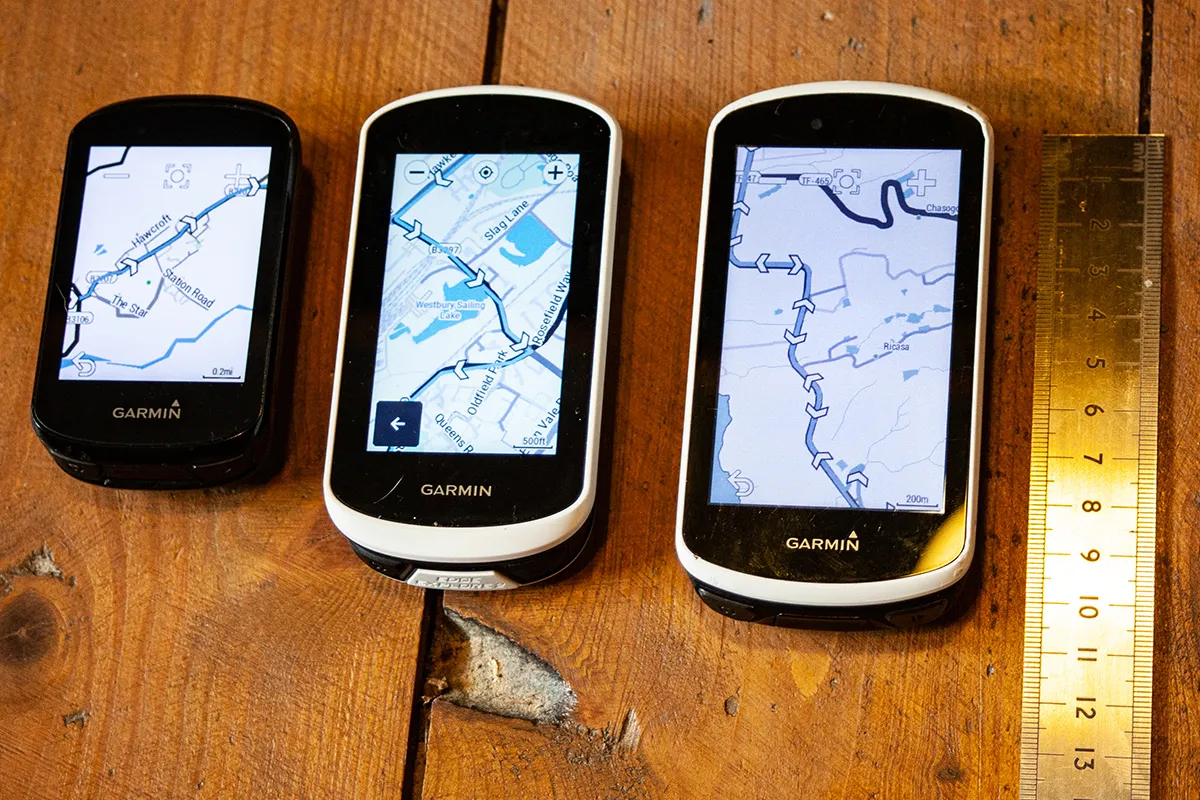Hot on the heels of the 2022 launch of Garmin’s latest flagship Edge 1040 bike computer comes the Edge Explore 2.
Positioned as a tool primarily for navigation, the Explore 2 strips away some of the myriad data the most expensive Edge bike computers offer riders.
In fact, if you can do without the frills offered by some other products in the ride-tracking powerhouse’s range, the Garmin Edge Explore 2 is a highly competent, good-value bike computer.
Garmin Edge Explore 2 specifications

Whereas the solar-screened Edge 1040 will set you back over £600, the Explore 2 can be had for less than half that price – a significant cost saving in anyone’s book.
The Explore 2 features a 3-inch screen, sitting between the diminutive Edge 830 and the larger dimensions of the 1040 (and its predecessor the 1030).
The display features 240x400 pixels, which – in terms of pixel density – puts it in the range of both the 1040 and 830.
The unit itself is built robustly, yet not a brick, weighing only 104g.
It comes with a USB-C port, which should mean no more fiddling trying to get the previously used micro-USB cable in the right orientation.

An IPX7 rating for water resistance (indicating the unit has been tested submerged in a metre of water for 30 minutes) should see you through any stormy wet winter rides safely.
In this guise, the Explore 2 lacks the power pin connections on the rear of recent Edge models, so it misses out on compatibility with Garmin's power-extending battery pack.
However, Garmin does offer a more expensive power mount bundle with the power pins at £339.99 (which can even take charge from an electric bike battery with the right connection).
However, if you want it you’ll have to choose it from point of purchase: this standard model as tested can’t be upgraded at a later date.
The Explore 2 offers a claimed 16 hours' battery life with GPS switched on and recording.
The main ‘catch’ with the Explore 2 is it lacks the full suite of features you get with Garmin’s other Edge models.
In terms of hardware, this means no Wi-Fi connectivity for direct uploading of your rides. Instead, it uploads to Garmin connect and Strava via your phone, just as older Garmins used to.
There’s also no Strava Live segment support (although you can still use Strava to plan and sync routes), so if you’re a KOM/QOM capturer, this may not be the unit for you.
Garmin has also ditched the ability to connect to electronic drivetrains.
The Explore 2 also cuts the majority of the structured training support now available on the higher-priced Edge computers.
For example, you still get Garmin’s recovery advisor feature, recommending a predicted recovery timeframe, but more detailed live analysis tools such as pedalling dynamics, training load and training effectiveness don’t make the cut.
However, unlike its Explore predecessor, it comes with both ANT+ and Bluetooth connectivity, bringing improved ability to connect to all the sensors you might want to use.
This brings power and heart rate monitoring, calorie tracking and more, plus compatibility to Garmin’s array of Varia light and Radar products.
It can even connect to, record from and operate a smart trainer.
In short, while the Explore 2 drops some of the features that may appeal to riders focused on performance with their daily rides and training, it keeps the fundamental features most other riders are ever likely to need.
Garmin Edge Explore 2 performance

The latest Garmin user interface is much improved compared to older models, and carries more information than before on the standard screen.
Location searching on the device is easy, and it now includes trendline information (selecting the route that’s most often cycled by Garmin Connect users). It can even show important weather information via your phone connection too.
The screen is both bright and crisp, and the touchscreen element is excellent and fast to respond. It worked well when I wore a range of long-fingered gloves too.
The redesigned interface makes connecting accessories a doddle. I’ve connected the Explore 2 to multiple sensors, including lights (such as Garmin’s Varia RCT715), a heart rate monitor and power meter.
I’ve made use of the unit’s ability to show live power, three-second average power, maximum power, average power and kilojoules expended.
Of course, if you’re a serious trainer interested in detailed live power metrics on your head unit (e.g. left-right balance, FTP analysis, and so on) the Explore 2 probably won’t meet your needs.
Nor might it if you want a fully connected system with your electronic drivetrain.
I think the omission here is a missed opportunity for the Explore 2, especially when you consider the arrival of more affordable electronic gearing with 105 Di2 and Rival AXS.
The Explore 2 seems like it could have been a natural companion for these drivetrains, found as they are on relatively affordable road bikes.
I definitely like looking at my data in detail from time to time, but even with this in mind I’m still impressed by what the Explore 2 offers.
It ties in the ability to record all the expected fundamental metrics, plus includes some less expected talents.

Notably, Garmin should be applauded for recognising that a smart trainer isn’t only for the rider dedicated to training and racing – many use one simply to maintain a level of fitness, so the ability to connect to one easily is a great bonus.
As the name suggests, though, this really is a bike computer for navigation, and Garmin is among the best (if not the best) in the business when it comes to getting you where you need to go.
The triple GPS, Glonass and Galileo satellite support means it finds its position quickly (much faster than my own Edge 1030, even) and it’ll store 100 routes and record up to 200 hours of riding history.
The map screen now has more detail compared to the original Explore and the high-traffic indicator (signified by a red dotted line) on roads helps you ride through towns and cities while avoiding traffic jams and busier roads.
In particular, the rerouting impressed me when I strayed off a planned course.
Make a wrong turning and the Explore 2 keeps you going in the right direction. It hasn’t once put me into an endless U-turn loop, which I’ve found some other systems can do.
Planned routes from both Strava and Komoot are compatible with the Explore 2, and I appreciated the inclusion of Garmin’s excellent ClimbPro function.
On the approach to a climb on your route that the Explore 2’s algorithm has recognised, ClimbPro switches the screen to a graphic of the upcoming ascent. It shows the elevation profile, as well as useful metrics such as distance to go, remaining grade per cent, ascent remaining, current grade and elevation.
It updates live as you climb, with the gradient graphic progressing from green through, yellow, orange and red to indicate the severity of the gradient.
Although often perceived as a performance tool, I think everyone can benefit from knowing what lies in store when climbing a hill. It helps you pace yourself and know when to take a breath and spin easy, and when you can afford to ride harder.

As I’ve mentioned, Garmin claims you’ll get around 16 hours' life from demanding use – this includes using it to navigate and/or with connections to sensors.
In testing, I saw around 15 hours between charges, with one or two sensors or peripherals connected for each ride.
If you’re not so power hungry, I’d suggest around 20 hours is feasible if you aren’t heavy on using the navigation and make use of the battery save mode when you can.
For eBike riders, the ability to connect to the Explore 2 is also a plus.
With a compatible system, you can get alerts on-screen of battery status, selected assistance level and more – in many cases, I think it can improve upon the displays supplied by motor providers.
Garmin Edge Explore 2 value for money
How you measure value will naturally depend on the features you really need – here, I think the Explore 2 is a very good-value option if you don’t need the almost-bewildering array of features offered by lots of other units.
As a point of comparison, the Hammerhead Karoo 2 offers a very large touchscreen and a regularly updated (improved) system, and has a premium smartphone-like feel about its interface. That said, you’ll need to spend £110 more at time of review to own one.
The Wahoo Elemnt Bolt V2 is priced similarly (just £15 more expensive), but has a relatively small screen with ease of navigation suffering as a result. It also doesn’t feature a touchscreen.
Garmin Edge Explore 2 bottom line

Despite missing out on some of the niche and detailed metrics and performance analysis tools, the Garmin Edge Explore 2 is still loaded with a compelling set of features for many (if not most) riders.
Ease of use and setup are all huge plus points too, thanks to Garmin’s improved interface, a clear and detailed screen and dependable re-routing.
The standard version tested here doesn’t get the power pins in the quarter-turn mount, so the fact it can’t be upgraded to use the power pack is a shame. I would have liked this to be a possible upgrade pathway at this price, rather than forcing you to spend £90 more for the option.
I also find the omission of connectivity to both Shimano Di2 and SRAM AXS drivetrains a snag, but it’s not likely to be a deal-breaker for most.
The Garmin Edge Explore 2 could be described as an ‘Edge-lite’, but for many prospective buyers, it will deliver all the bike computer you ever need at a decent price.
Product
| Brand | Garmin |
| Price | €299.00, £250.00, $299.00 |
| Weight | 104g |
Features
| Rechargeable battery | yes |
| Screen type | touchscreen |
| Connectivity | antPlus |
| Connectivity | bluetooth |
| Dimensions | 106.1x 55.7 x 20.6 mm |
| Battery life | up to 16 hours |
| Water resistance | IPX7 |
| Screen dimensions | 3in |
| Display resolution | 240 x 400 pixels |

